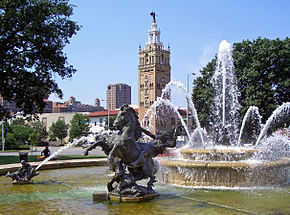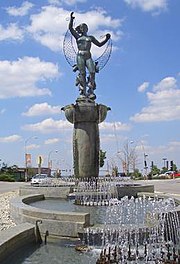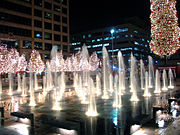
A fountain, from the Latin "fons", meaning source or spring, is a decorative reservoir used for discharging water. It is also a structure that jets water into the air for a decorative or dramatic effect.
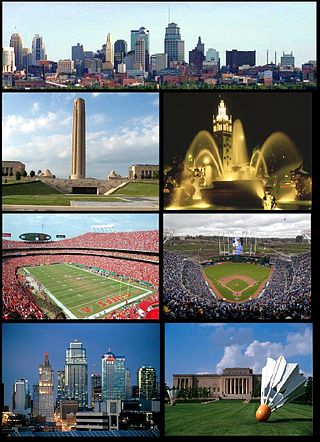
The Kansas City metropolitan area is a bi-state metropolitan area anchored by Kansas City, Missouri. Its 14 counties straddle the border between the U.S. states of Missouri and Kansas. With 8,472 square miles (21,940 km2) and a population of more than 2.2 million people, it is the second-largest metropolitan area centered in Missouri and is the largest metropolitan area in Kansas, though Wichita is the largest metropolitan area centered in Kansas. Alongside Kansas City, Missouri, these are the suburbs with populations above 100,000: Overland Park, Kansas; Kansas City, Kansas; Olathe, Kansas; Independence, Missouri; and Lee's Summit, Missouri.
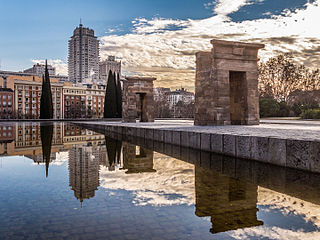
A reflecting pool, also called a reflection pool, is a water feature found in gardens, parks and memorial sites. It usually consists of a shallow pool of water with a reflective surface, undisturbed by fountain jets.

The Country Club Plaza is a privately owned regional shopping center in the Country Club District of Kansas City, Missouri. Opened in 1923, it was the first planned suburban shopping center and the first regional shopping center to accommodate shoppers arriving by car.

Carl Milles was a Swedish sculptor. He was married to artist Olga Milles and brother to Ruth Milles and half-brother to the architect Evert Milles. Carl Milles sculpted the Gustaf Vasa statue at the Stockholm Nordic Museum, the Poseidon statue in Gothenburg, the Orpheus group outside the Stockholm Concert Hall, and the Fountain of Faith in Falls Church, Virginia. His home near Stockholm, Millesgården, became his resting place and is now a museum.

Garfield Park is a 128-acre (52 ha) urban park in Indianapolis, Indiana, United States. Established in the late 19th century, it is the oldest city park in Indianapolis and is on the National Register of Historic Places. The park is located at the confluence of Pleasant Run and Bean Creeks on the near Southside of Indianapolis. The 10,000-square-foot (930 m2) Conservatory and Sunken Gardens are located in the eastern portion of the park. The noted landscape architect George Edward Kessler designed the Sunken Gardens along with many of the other features of the park as part of his Park and Boulevard Plan for the city.
The list of neighborhoods of Kansas City, Missouri has nearly 240 neighborhoods. The list includes only Kansas City, Missouri and not the entire Kansas City metropolitan area, such as Kansas City, Kansas.
Windsor's Department of Parks and Recreation maintains 3,000 acres (12 km2) of green space, 180 parks, 40 miles (64 km) of trails, 22 miles (35 km) of sidewalk, 60 parking lots, vacant lands, natural areas and forest cover within the City of Windsor, as well as the Bike Trails, Bike Lanes, and Bike-Friendly Streets.

Ward Parkway is a boulevard in Kansas City, Missouri, United States. Ward Parkway begins at Brookside Boulevard on the eastern edge of the Country Club Plaza and travels west 2.8 miles along Brush Creek as U.S. Route 56 before turning south near Kansas-Missouri state line. It continues south for 4 miles, terminating at Wornall Road near Bannister Road. A short spur, Brush Creek Parkway, connects Ward Parkway to Shawnee Mission Parkway at State Line Road.

The Paseo is a major north–south parkway in Kansas City, Missouri. As the city's first major boulevard, it runs approximately 10 miles (16 km) through the center of the city: from Cliff Drive and Lexington Avenue on the bluffs above the Missouri River in the Pendleton Heights historic neighborhood, to 85th Street and Woodland Avenue. The parkway holds 223 acres (0.90 km2) of boulevard parkland dotted with several Beaux-Arts-style decorative structures and architectural details maintained by the city's Parks and Recreation department.
Main Street or Main is one of the major streets in Kansas City, Missouri and the Kansas City metropolitan area. Main Street serves as the main administrative dividing line for house numbering and east–west streets in Kansas City; for example, it separates East 59th Street from West 59th Street. Address numbers on east–west streets increase in both directions as one moves away from Main Street. This should not be confused with the Kansas City "East Side" and "West Side," a cultural distinction which has arisen from a history of racist segregation in the city, separated by Troost Avenue approximately 1 mile east of Main Street.
Volker Boulevard or Volker is a major west/east main street that runs along U.S. Route 56 in Kansas City, Missouri. It starts at Ward Parkway and Brookside Boulevard near the Country Club Plaza along Brush Creek and ends at Swope Parkway and Paseo Boulevard.

Henri-Léon Greber was a French sculptor, and medallist. His son was the architect Jacques Gréber. Active in the United States, he produced a fountain sculpture of four equestrian statues for Harbor Hill in 1910, and the copy of The Kiss in the Philadelphia Rodin Museum.

Hyde Park is a historic residential neighborhood and city park in Kansas City, Missouri.

The Gateway Mall in St. Louis, Missouri is an open green space running linearly, one block wide, from the Gateway Arch at Memorial Drive to Union Station at 20th Street. Located in the city's downtown, it runs between Market Street and Chestnut Street.
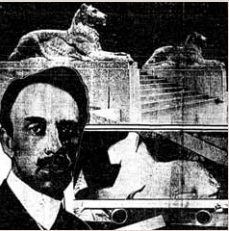
Jørgen Christian Dreyer was a Norwegian-born American sculptor. He emigrated to the United States in 1903 and worked as a professor of sculpture at the Kansas City Art Institute from 1907 to 1909. In his career Dreyer created a number of monumental sculptures, some of which are located in Kansas City, Missouri. His major works include: Life Drift; The Goddess of Dawn; Sphinxes (pair); Biology and Chemistry ; Lionesses (pair); The Message ; Bust of Sir Carl Busch; Mercury, god of commerce; and Bust of Major General Sterling Price.

The Ewing and Muriel Kauffman Memorial Garden is a 2-acre botanic garden and part of the Kauffman Legacy Park, located in Kansas City, Missouri. It is maintained in a collaborative effort by the Ewing Marion Kauffman Foundation and Powell Gardens. The gardens are located near Country Club Plaza and the main campus of University of Missouri–Kansas City. The Kauffman Memorial Garden is enclosed by limestone walls and has brick paths and seating areas. The garden showcases five designs.
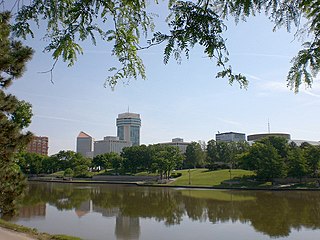
Downtown Wichita is the central business district, government and social core of the Wichita metropolitan area, in the U.S. state of Kansas. It is home to several of the area's major landmarks and event venues including the Epic Center, Century II Performing Arts & Convention Center, Intrust Bank Arena, Riverfront Stadium, Keeper of the Plains sculpture, the Old Town entertainment district, and the historic Delano neighborhood.
